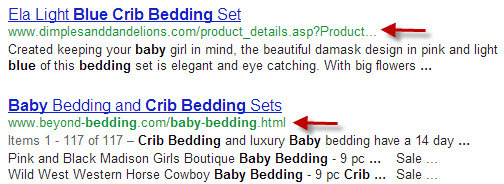The ecommerce platform that hosts a site determines the URL structure, which in turn can have an impact on the site’s search engine optimization. Each platform creates URLs according to its own rules, but nearly all can be modified for greater SEO and brand recognition.
In years past, URLs with lots of folders and parameters posed major crawl issues for the search engines. In some cases the “spider traps” created by complex ecommerce URLs would even prevent the engines from indexing a site, effectively cutting off the flow of organic search customers.
Google and Bing are much more capable of crawling or intelligently ignoring parameters and long, scraggly folder paths in URLs today, but optimal URLs do play a role in SEO. Using descriptive words in URLs gives the search engines yet another algorithmic insight into the types of searches the page would be relevant for. In addition, customers reviewing their search results can see the URL displayed and gain or lose confidence in that page’s ability to fulfill their need.
Which of these URLs inspires more confidence in the page’s relevance? Enlarge This Image
Enlarge This Image

What Makes a URL Optimal?
Optimal URLs are short, static, relevant and unique. The relevance factor is the simplest piece to understand. Consider a site that men’s clothing that sells many different brands. A URL for a product page featuring a pair of Levi’s blue jeans should logically contain the brand and product name, such as www.fakesite.com/levis-501-original-fit-jeans.
If different colors are represented on different pages the color may need to be included as well, such as www.fakesite.com/levis-501-original-fit-jeans-dark-stonewash. The need to make URLs unique can lead to overly long URLs, especially on ecommerce sites with large catalogs of products. If keyword URLs will become overly long, a product number can be included to serve as the unique identifier so that all identifying product name words don’t need to be listed in the URL — for example, www.fakesite.com/levis-501-original-fit-jeans-123456.
Keyword research will indicate which category and product attributes are important to searchers. Ideally, these search-valuable attributes would then be incorporated into the URL as space allows. The order in which searchers structure their queries should also be studied to determine not only which attributes are most valuable but the order in which searching customers prefer to receive them.
In some cases, category and product names are not very descriptive on their own and can benefit from having additional keywords added. Use this option with care, it’s very easy to get carried away and produce over-optimized URLs. But unless the product names on a site are generally descriptive or the product names have strong brand recognition themselves, product name based-URLs will probably not be as beneficial to SEO.
Teva’s boots are a perfect example of when adding keywords to the URL makes sense. The “Men’s Chair 5” product name gives no clue as to what type of product is for sale, except that it’s intended for use by men. A strictly product name-based URL would read www.teva.com/mens-chair-5/1001468,default,pd.html. It’s short and static, but it doesn’t convey a sense of what the product is. Teva added “lightweight-winter-boots” to the URL to clarify the product’s relevance: http://www.teva.com/mens-chair-5-lightweight-winter-boots/1001468,default,pd.html. I probably would have left “lightweight” out to keep it shorter and because it’s not a valuable search attribute, but it’s not excessively long as it is.
URL Length & Structure
Optimal length for URLs is somewhat more subjective. The goal is to make them relevant without appearing spammy or overstuffed with keywords, and to make them visually appealing to customers. There’s a lot of room for subjective opinion in that guideline, but I like to shoot for three to five words that focus on the unique relevance of the item or items on that page.
Sometimes it’s easy to tell when a URL is too long than when it’s not. For example, take a look at the URLs below ranking for “Schlage keypad entry lock.”
Examples of short and long URLs




The last aspect of optimal URLs is the structure. A few basic rules cover all URLs.
- Use only lowercase alphanumeric characters (abc123).
- Replace spaces, underscores and other word separators with hyphens (-).
- Remove all special characters, including trademark symbols, exclamation points, and apostrophes.
- Remove all encoding that represents special characters, such as %20, %2C.
The developers who manage the hosting and server-level aspects of the ecommerce site will be able to turn these guidelines in to the rewrite rules needed to convert the default URLs your platform generates into SEO and customer friendly URLs.
Unless URLs have been confirmed by a technical SEO expert to cause major problems driving organic search traffic, URL rewrites should only be done when a page is first launching or during a site redesign or replatforming. URLs and links make up the roadmap that search engines use to navigate a site. Changes in that roadmap can negatively affect SEO performance, as described in “SEO: Identifying the Impact of a Site Redesign.”
URLs are not the magic solution to better SEO, but they are one of the many factors that make up the search engines’ various algorithms. Some of the URLs used as negative examples here rank very well. But consider this: Could they rank even better with optimal URLs? Probably. And do the sites that rank well with suboptimal URLs tend to have extremely strong link profiles and brand recognition? Yes.
As one of the tools available to fight the war for rankings, URL optimization can give you an edge over larger and stronger brands.





